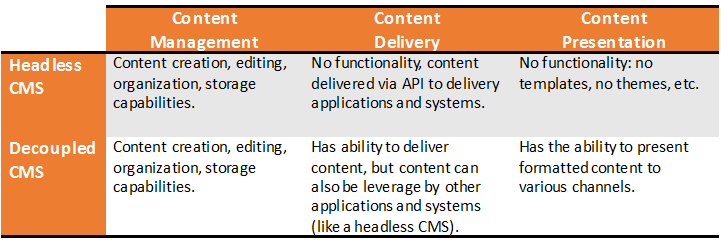Headless CMS for Ultimate Content Flexibility
As advisors to enterprise buyers of technology and services, you might think we answer the same questions time and time again. But every so often something new arises in the discussions. Meme-like, this topic  suddenly seems to pop up in every customer conversation. A few years ago it was the question of going to the cloud or remaining on premises, prior to that it was the need for responsive design. The meme going around right now is “Should we go headless?”. Rather than questioning the tenure of their CDO, folks are playing with the notion of disengaging their data from a particular process or technology. To put it another way, buyers are wondering about and wanting to cut their content free of the shackles of traditional CMSs so that they can use it any which way they like.
suddenly seems to pop up in every customer conversation. A few years ago it was the question of going to the cloud or remaining on premises, prior to that it was the need for responsive design. The meme going around right now is “Should we go headless?”. Rather than questioning the tenure of their CDO, folks are playing with the notion of disengaging their data from a particular process or technology. To put it another way, buyers are wondering about and wanting to cut their content free of the shackles of traditional CMSs so that they can use it any which way they like.
It’s a good idea in theory but the practicality and detail of the approach are more complex. So let’s start off with a bit of clarity around the terminology.
At the core, there are three key components that distinguish content management systems: content management/editing, content delivery, and content presentation. In terms of setting content free, there are two tech terms making the rounds: Headless CMS and Decoupled CMS. To industry insiders, these are not new terms. And let’s be clear – they mean different things and are not interchangeable. In the diagram below you can see that Headless CMS really means having a Content Management repository system that is independent of content delivery and presentation tools. Whereas a Decoupled CMS is essentially a regular full stack of content management, delivery, and presentation solution but allows for content stored within it to be leveraged by other systems.

To be clear, one of the big differences between the two is that a headless CMS requires a separate solution to deliver/render the content, whereas a decoupled CMS may have the necessary functionality built into it, but can also peacefully coexist with other solutions to present the content. Many of today’s modern CMSs can work as a headless or decoupled CMS.
The R.O.I. of a headless CMS:
R: Reach
Content needs of today go way beyond populating a website. Content is the thread that pulls customers in and through (at any stage of their journey) to provide connected brand experiences across all possible digital and in-person interactions. A headless CMS provides the flexibility of content deployment to be able to reach customers where they are by serving up the right content to the right individual at the right time in the right format.
O: Optimize
Create once and use over, and over, and over again is the mantra of a headless CMS. Not being tied to a delivery or presentation layer means content can be created once and reused, in many different formats and presentations, saving time and effort. A headless CMS can automatically push new or updated content across all the digital properties with which it is connected.
I: Interact
Being able to send content into new and evolving channels and applications in real time is a critical success factor to delivering great customer experiences. The faster content can be rolled out to new apps, the better the experience for the customer. A headless CMS can make it easier to interact with content-enabled applications via APIs. APIs allow developers to work around content deployment and presentation issues that can bog down the process and time-to-market that companies face with many traditional/coupled CMS systems.
Do I have to buy a new CMS to go headless?
No. The good news is that with the increasing need/demand for great content deployment flexibility many developers have begun decoupling traditional CMS solutions allowing it to be used as a content management, editorial, and administrative tool, while implementing a separate frontend component that communicates with other solutions and CMSs via APIs for the delivery of the content. This helps site owners future-proof their technology stack by allowing them to refresh the design without re-implementing the whole CMS.
When does it make sense to go headless?
You might have a number of web properties with a variety of user interactivity supported by different solutions but share content. A headless CMS environment would provide a central place to store and edit the content for all of the outlets. Or perhaps you need content fed to a smartphone or a html5 app – a headless CMS precludes the need to build bespoke content management functionality into those apps. You can simply use that is already there. This shift away from an “all-in-one” CMS solution to one that focuses on managing the content, not the experience, can help companies deliver richer more responsive customer experiences.
Is headless CMS another fad?
The buzz of late has been about the benefits of a headless CMS and the flexibility it offers. A headless CMS says "let's free our content to be anything, and anywhere, it needs to be" which is highly appealing in a world where customer experience demands a more and more tailored and personalized experience for each customer with each passing day. In a sense, it is a fad and one that is engaging many of DCG’s customers. All in all it’s a good fad for people to be thinking about as it shows real tech buyer maturity as they start to think creatively about building systems today that will be able to provide a foundation for both the numerous publishing channels we know about, as well as those that are yet to come in this ever evolving content world.

Cathy McKnight
A founding partner with Digital Clarity Group, Cathy has a passion for working with clients to maximize their potential for success and profitability by helping them find the right-fit digital technology to help maximize their online engagement and efficiencies, within and outside the firewall. Cathy assists clients understand the value of their online technology and put it to use to embrace their digital transformation from being information based to engagement focused.